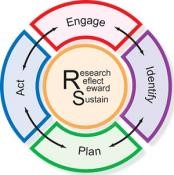Planning
Planning is one of the most important project management and time management techniques. Planning is preparing a sequence of action steps to achieve some specific goal. If a person does it effectively, they can reduce much the necessary time and effort of achieving the goal.

Planning can be defined as “thinking in advance what is to be done when it is to be done, how it is to be done and by whom it should be done”. In simple words we can say, planning bridges the gap between where we are standing today and where we want to reach.
Planning involves setting objectives and deciding in advance the appropriate course of action to achieve these objectives so we can also define planning as setting up of objectives and targets and formulating an action plan to achieve them.
Another important ingredient of planning is time. Plans are always developed for a fixed period as no business can go on planning endlessly.
The essential moment of planning is Visioning
What is it?
Visioning is just as it sounds, the process used to brainstorm then develop a desired long term vision for the training. It answers “What do we want to achieve?”, “What will we look like?”, “Which will be our group ?”, etc.
Why is it important?
The vision is one of the key foundation pieces that guide your plan. Which strategic projects/training you choose is based on the vision you want to achieve. The visioning process is critical in helping leadership design a statement that is a real stretch for the training in general. The result of the process should be a statement that makes the team gulp or sweat a little but also inspires them to move forward with enthusiasm, not shrink back in trepidation.
How do you do it?
Visioning is a simple process, though the “wordsmithing” of the results takes some skill. Begin by asking the team to envision the future 15-25 years down the road). What are group members doing? What does the plenary look like? Who are your participants? What do they say about you? What has been accomplished that you are particularly proud of?
When the group has a clear vision of what that ideal future looks like, have each member write down a list of their essential pieces. While one person records the responses on a flipchart, whiteboard or projector, have each team member share one piece of their picture, continuing round-robin through the group until all the pieces are recorded.
Importance of planning
1. Planning helps identify goals
One of the most beneficial aspects of planning is in creating goals to accomplish. When you sit down and write out what you want to accomplish you will be surprised how this goal structure lends itself to creating a plan for accomplishing them. There are a couple of different strategies when working on goals. Some of the more popular include creating three goal types, short-term, mid-term, and long-term.
Short-term goals are those items you would like to see done in the next 2-3 days. These goals are quick, easy to accomplish and relatively simple goals. The mid-term goals are things you’d like to accomplish in the next few weeks or months. This is the broadest time scope and can vary in degree of difficulty. Ultimately each of these mid-term goals is concrete, well-defined goals that can be directly actioned. The last goal type is the long-term goal. These goals are much more abstract and contain a more figurative type of language. These are the big picture goals and long-term aspirations you hold for your project.
2. Planning offers directions
If you start creating your goals in the first step and organize them accordingly what you’ll find is you’ve begun to take the first step towards creating a roadmap. Planning a direction for your project or training involves creating a roadmap. Planning takes many different shapes and sizes and as you create this roadmap for accomplishing your goals you will find your planning is offering you great direction.
This direction allows you to plan for a course of action you will take to accomplish your goals. Planning how you accomplish them is a valuable exercise for your personal growth and development. As you plan you will put together a course of action. This course of action will help you to be prepared for what comes next. You’ll be ready to answer questions and you’ll have an advantage over others which have not prepared for their future.
3. Planning uncovers problems
You create your goals and identify your direction and you become prepared for what is coming next. The more prepared you are the better you can handle problems as they arise. Even more than handling problems as they arise the art of careful planning will help you to uncover potential problems before they even occur. When you work to carefully plan out a direction you’ll undoubtedly uncover possible bumps in the road along the way. If you aren’t careful in your planning you may never discover them until its too late.
Uncovering problems means finding solutions and implementing fixes before they become a reality. There are few things as exciting as fixing problems before they are ever found. Being able to resolve conflicts and work around issues is an invaluable business advantage. Careful planning helps uncover problems.
-
Planning adds professionalism
Professionalism doesn’t mean stiff and stodgy. Just because you are professional it doesn’t mean you can’t have fun. Professionalism means you are prepared. Preparation is another word for planning. Planning adds a sense of professionalism to your training. When you plan your course of action, when you outline your goals, and when you uncover problems you allow yourself to be prepared for things that arise.
Being prepared keeps you from getting caught off-guard if things don’t go as planned. This is an important point. Planning does not mean everything always works as you intend. Errors, problems, and failures will still happen. Planning helps you stay professional as you handle those times. Planning keeps you prepared for when things don’t go as you hoped.
5. Planning gives perspective
Lastly, planning your goals and your direction helps to give you a clear perspective of what matters and what is possible to accomplish. As you create your goals you will focus on what you want to accomplish. Planning how to accomplish those goals will force you to organize them and also to prioritize them and put them in perspective. No one wants to waste time working on something that is not important. However, the day to day life of a trainer easily gets overwhelmed and those goals and objectives get lost in the daily grind.
Planning helps to stay focused and to keep your perspective. Keep your perspective on your purpose and your future. Then and only then will you see success and you will be rewarded for your planning.
What is the action plan? (remember this goes for every training before, while and after it happened)
Generally, it’s a proposed strategy or course of action. Specifically, in project management, it’s a document that lists the steps needed to achieve a goal. That is, an action plan clarifies what resources you’ll need to reach that goal, make a timeline for the tasks to get to that goal and determine what resources you’ll need to do it all.
How to Create an Effective Action Plan
Know what you want to do. The less clear you are about what you want to do, the less effective your plan will be. Try to specifically define what you want to achieve as early as possible — preferably before starting your project.
Work backward from your end goal. Identify your end goal, then list everything you need to do to accomplish it. Depending on your goal, you may even consider different ways to reach your goal. After you know what you need to accomplish, break this down into actionable steps to help you create a more realistic plan.
- Keep in mind that your plan may change as you work toward your goal, so stay flexible.
- Make sure that your goals are S.M.A.R.T. to ensure that your plan is effective:[1]
- Specific – Be clear about what you want to achieve.
- Measurable – You can break down the goal into measurable checkpoints.
- Attainable – You are capable of completing the steps necessary to reach the goal.
- Relevant – The goal makes sense for your life and purpose.
- Timely – You have the time to work toward your goal and are progressing on schedule.
Be specific and realistic in your planning. Having a specific goal is just the beginning: you need to be specific and realistic in every aspect of your project — for example, by stating specific and achievable schedules, milestones, and outcomes.
- Being specific and realistic while planning a long project is all about proactively reducing the stress that can accompany poorly planned projects such as missed deadlines and exhausting long hours.
Set measurable milestones. Milestones mark significant stages along the road to achieving your end goal. Create milestones easily by starting at the end (the accomplishment of the goal) and working your way back to your present-day and circumstances.
- Having milestones can help you — and if applicable, your team — stay motivated by breaking the work into smaller chunks and tangible goals so that you don’t need to wait until the project is finished to feel as though you’ve accomplished something.
- Don’t leave too much time or too little time between milestones — spacing them two weeks apart is effective.
Break large tasks into smaller, more manageable chunks. Some tasks or milestones may seem more daunting to achieve than others.
- If you’re feeling overwhelmed by a large task, you can help ease your anxiety and make it feel more doable by breaking it down into smaller, more manageable chunks.
Make scheduled lists. Make a list of tasks that you need to complete in order to hit your milestones. A list on its own will not be effective — you must write this list into a timeline associated with specific, realistic actions
Put timelines on everything. Without specific time frames and deadlines, work will definitely expand to fill the time allotted, and some tasks may never get completed.
- No matter what action items you choose for which phase of your action plan, it is essential that a time frame is attached to absolutely everything.
Mark things off as you go. Marking things off as you go will not only feel satisfying, it will help you keep on track lest you forget what you’ve already done.
- This is particularly important if you’re working with other co-trainers.
Keep a record of everything. As you work through your action plan, keep notes of everything. You may find it helpful to have a binder with different tabs in it to section off different aspects of your planning process. Some examples of sections:
- Ideas/Miscellaneous notes
- Daily Schedules
- Monthly Schedules
- Milestones
- Research
- Follow-up
- Individuals involved/Contacts
Don’t stop until you’ve reached your final goal. Once your plan is established and shared with the team (if applicable), and your milestones are scheduled, the next step is simple: take daily actions to achieve your goal.
- Although you want to stay persistent, you should also be flexible. Unexpected events will likely come up that require you to shift your schedule or plan.
Change the date if you must, but never give up on your goal. Occasionally, circumstances or unforeseen events can arise that throw a wrench in your ability to meet deadlines, complete tasks and achieve your goal.
- If this happens, do not get discouraged – revise your plan and continue working to meet targets and move forward.
Create a to-do list. One of the most important reasons for keeping a to-do list is the organization. Organizing your tasks with a list can make everything much more manageable and make you feel grounded. Seeing a clear outline of your completed and uncompleted tasks will help you feel organized and stay mentally focused.
For a more realistic action plan, you have to be in step with time.
So time management is very important when planning
Time management is the process of planning and exercising conscious control of time spent on specific activities, especially to increase effectiveness, efficiency or productivity.
Time management is the ability to plan and control how someone spends the hours in a day to effectively accomplish their goals. This involves juggling time between the domains of life—work, home, social life, hobbies. It is important to establish clear goals and priorities to set aside non-essential tasks that can eat up time and to monitor where the time actually goes.
Planning plays a pivotal role in effective time management. A trainer needs to plan his day well in advance to make the best possible use of time. There is no point in working just for the sake of doing work. Planning gives an individual a sense of direction in the organization and motivates him to complete assignments on time.

Reflection questions:
- Think a situation that could have been better if you planned it better? Why would it be better?
- Which of the stages do you think is the most important when planning? And why?
- What are the benefits and advantages of planning? And what are the weaknesses and disadvantages?
Exercises:
To learn the plan, let the participants plan next day`s energizers, lunches, traditional evening, presentation, to invent a game, but give them specific tasks, like
– Timeline
– Team
– Goal
– Guest list
– Date and time
– Venue
– Logistic





